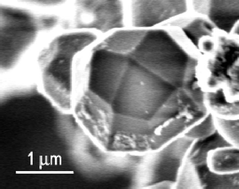On the use of polymeric dispersant P123 in the synthesis of bicontinuous cubic mesoporous AMS-6†
Abstract
An in-depth study of the synthesis and growth of bicontinuous cubic mesoporous AMS-6 material in the presence of polymeric dispersant P123 is presented, resulting in controlled particle shape attainable over a small range of synthesis conditions. Unlike previous syntheses a remarkable effect on facet formation of the Ia![[3 with combining macron]](https://www.rsc.org/images/entities/char_0033_0304.gif) d silica particles with cubic morphologies is observed. Trapezoidal icositetrahedra, spherical and elongated morphologies have been prepared with increased faceting on addition of higher concentration of dispersant. Particles are characterised extensively by
d silica particles with cubic morphologies is observed. Trapezoidal icositetrahedra, spherical and elongated morphologies have been prepared with increased faceting on addition of higher concentration of dispersant. Particles are characterised extensively by ![[3 with combining macron]](https://www.rsc.org/images/entities/char_0033_0304.gif) m.
m.


 Please wait while we load your content...
Please wait while we load your content...